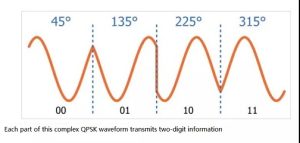Why is radio frequency (RF) so important?

The invention of electricity spurred the second industrial revolution. When we think of electricity, we first think of all kinds of wires, from high-voltage transmission lines to tiny wires on circuit boards. Wires transmit electricity from one place to another. The basic method of office. But people are not satisfied with the application of electricity. It’s like Tesla’s electromagnetic charging, which allows electricity to be transmitted wirelessly, just like Hertz’s electromagnetic wave experiment and later Marconi’s transatlantic communication. People are eager to be able to be liberated from the wired, anytime, anywhere communication-the Internet of Everything. The radio frequency RF is the basic way of interconnecting everything.
What is radio frequency?
The essence of radio frequency is electromagnetic radiation EMR, and electromagnetic radiation involves electric and magnetic fields. In fact, if there is a voltage, then there is an electric field (mathematically speaking, the spatial rate of change of the voltage and the electric field is proportional). If there is a current, Then there is a magnetic field (the intensity of the magnetic field is proportional to the magnitude of the current). In other words, as long as there are voltages and currents, there are electric and magnetic fields. Will the presence of electric and magnetic fields necessarily produce electromagnetic radiation? Can electromagnetic waves be generated? No, according to Maxwell’s equations, we know that only changing electric and magnetic fields can generate electromagnetic waves, as shown in the figure below.

In this sense, we need varying voltage and current. The key to this propagation phenomenon is the self-sustaining relationship between the electromagnetic components of electromagnetic radiation. A changing electric field produces a magnetic field, and a changing magnetic field produces an electric field. This mutual regeneration manifests itself as a unique entity, namely electromagnetic waves. Once generated, this wave will propagate outward from its source, advancing toward unknown depths at the speed of light day after day.

The definition of electromagnetic radiation
Electromagnetic radiation is actually very simple, as mentioned above, as long as there is a changing electric and magnetic field, electromagnetic waves can be generated. In a circuit, any changing current/voltage will generate electromagnetic radiation, even digital signals. In most cases, these electromagnetic radiations only generate noise. If there is no interference to the communication system, we can completely ignore it. But once there is interference to the communication system, it becomes electromagnetic interference EMI, and we need to find ways to filter it out. We see that RF design is more than just generating EMR; on the contrary, RF design is the art and science of generating, manipulating, and interpreting EMR, which allows you to reliably transmit meaningful information between two circuits that are not directly electrically connected.
To a certain extent, the design of any wireless system is to find ways to generate electromagnetic radiation and control useful electromagnetic radiation. This useful electromagnetic radiation constitutes the basis of wireless wireless and is also our RF research and design.
Advantage of electromagnetic radiation
In this respect, electromagnetic radiation is a good wireless extension of telecommunications used in wired circuits. Whether we like it or not, currents and voltages that change over time will produce electromagnetic radiation EMR, which is an accurate representation of the AC component of the original signal. As shown below

This controllable electromagnetic radiation is extremely sensitive and powerful. Even the complex high-frequency waveforms used in the most advanced wireless systems, the transmitted RF signals can be faithfully reproduced. Moreover, this electromagnetic wave travels extremely fast, propagating at the speed of light. If you use another signal carrier, the propagation speed may be greatly reduced.
In addition to the fast propagation speed, the propagation distance of electromagnetic radiation is also considerable. The pursuit of wireless communication is closely related to the pursuit of long-distance communication; if the transmitter and receiver are very close, it is usually simpler and more cost-effective to use wires. Although according to the inverse square law, the strength of the RF signal will be reduced, the combination of EMR with modulation techniques and complex receiver circuits still has a significant ability to transmit usable signals over long distances.
What’s more amazing is that the propagation of electromagnetic waves in the radio frequency band can also penetrate walls, plastic media and other things used in daily life. Unlike light, it can only propagate at line-of-sight. Its application also has great flexibility. Moreover, some low-frequency electromagnetic radiation is almost everywhere.
Is there any other signal carrier that can replace radio frequency?
Quantum communication? Optical Communication? Or what other new communication technology?




